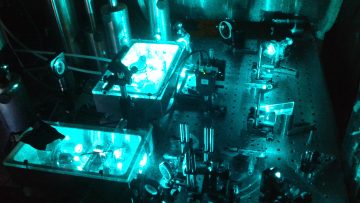Overview
In fall 2017, the Japanese-Canadian TUCAN (TRIUMF Ultra Cold Advanced Neutron) collaboration succeeded for the first time in producing ultracold neutrons (UCN). This was a major milestone towards the search for the elusive neutron electric dipole moment (nEDM). UCN move so slowly, about 5 meters per second compared to about 500 meters per second for air molecules, and with such low energy that they can be contained and observed. Thus, UCN are ideal for determining the neutron electric dipole moment (nEDM), which TUCAN aims to measure with the highest-ever precision. The nEDM is predicted to be vanishingly small, but if it is measured to be larger than expected, the TUCAN results could aid in solving a key cosmic puzzle: why there is much more matter than antimatter in the universe.
TRIUMF’s UCN facility is aiming to be the world’s highest-density source of ultracold neutrons. High density is critical to the research because most ultracold neutron experiments are statistics limited—the experiments require enormous numbers of individual measurements to arrive at a statistically reliable result. To support this effort, Momose group is developing atomic magnetometers based on the optical pumping of 199Hg and 129Xe isotopes, which will cohabit with UCN inside the nEDM experimental chamber, and will measure fluctuations of the magnetic field on the ppb scale. We have succeeded in producing laser-polarized 199Hg with orders of magnitude greater polarization than that obtained in a commercial NMR machine. We are now working to identify sources of systematic error, and push the measurement precision to its ultimate limit.
For an overview of TUCAN visit an overview of TUCAN and the project page.
-
Long term goal
- Develop laser- and lamp-based atomic vapour magnetometry based on the optical pumping of 199Hg and 129Xe isotopes.
-
Recent work
-
Development of a high-power, narrow-linewidth continuous-wave UV laser.
-
Doppler-free spectroscopy of Xe 5p-6p two-photon transition hyperfine splitting and isotope shifts.
-
Production of hyperpolarized 129Xe via Spin-exchange optical pumping (SEOP).
-
-
Current status
- Laser-based production of polarized 199Hg vapour and characterization of low-field magnetic resonance
- Characterizing VUV lamp-based production & detection of polarized 129Xe.
 Optical pumping setup for Hg magnetometry tests. |
 Intense narrow UV laser light created by Second Harmonic Generation in optical cavities. |
 199Hg optical pumping cell inside magnetic shields. |
 Future magnetometer application in TRIUMF nEDM experiment (right). |
-
Recent publications
- “Characterization of electroless nickel-phosphorus plating for ultracold-neutron storage.”
H. Akasaka et al (TUCAN collaboration), Nucl. Instrum. Methods Phys. Res. A, 1049, 168106 (2023) -
“Estimated performance of the TRIUMF ultracold neutron source and electric dipole moment apparatus.” S. Sidhu et al. (TUCAN Collaboration) EPJ Web of Conferences 282, 01015 (2023)
- “The Precision nEDM Measurement with UltraCold Neutrons at TRIUMF.”
R. Matsumiya et al (TUCAN collaboration), JPS Conf. Proc. 37, 020701 (2022) -
“First ultracold neutrons produced at TRIUMF.”
S. Ahmed et al. (TUCAN Collaboration) Phys. Rev. C 99, 025503 (2019) -
“High-resolution two-photon spectroscopy of a 5p56p ← 5p6 transition of xenon.”
Emily Altiere, Eric R. Miller, Tomohiro Hayamizu, David J. Jones, Kirk W. Madison, and Takamasa Momose, Phys. Rev. A, 97, 012507 (2018)
- “Characterization of electroless nickel-phosphorus plating for ultracold-neutron storage.”
